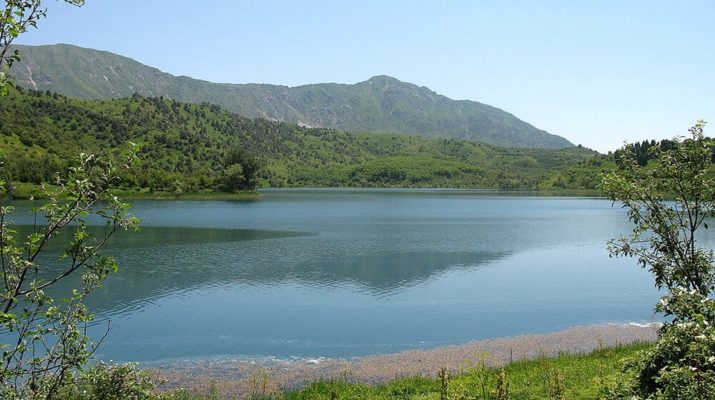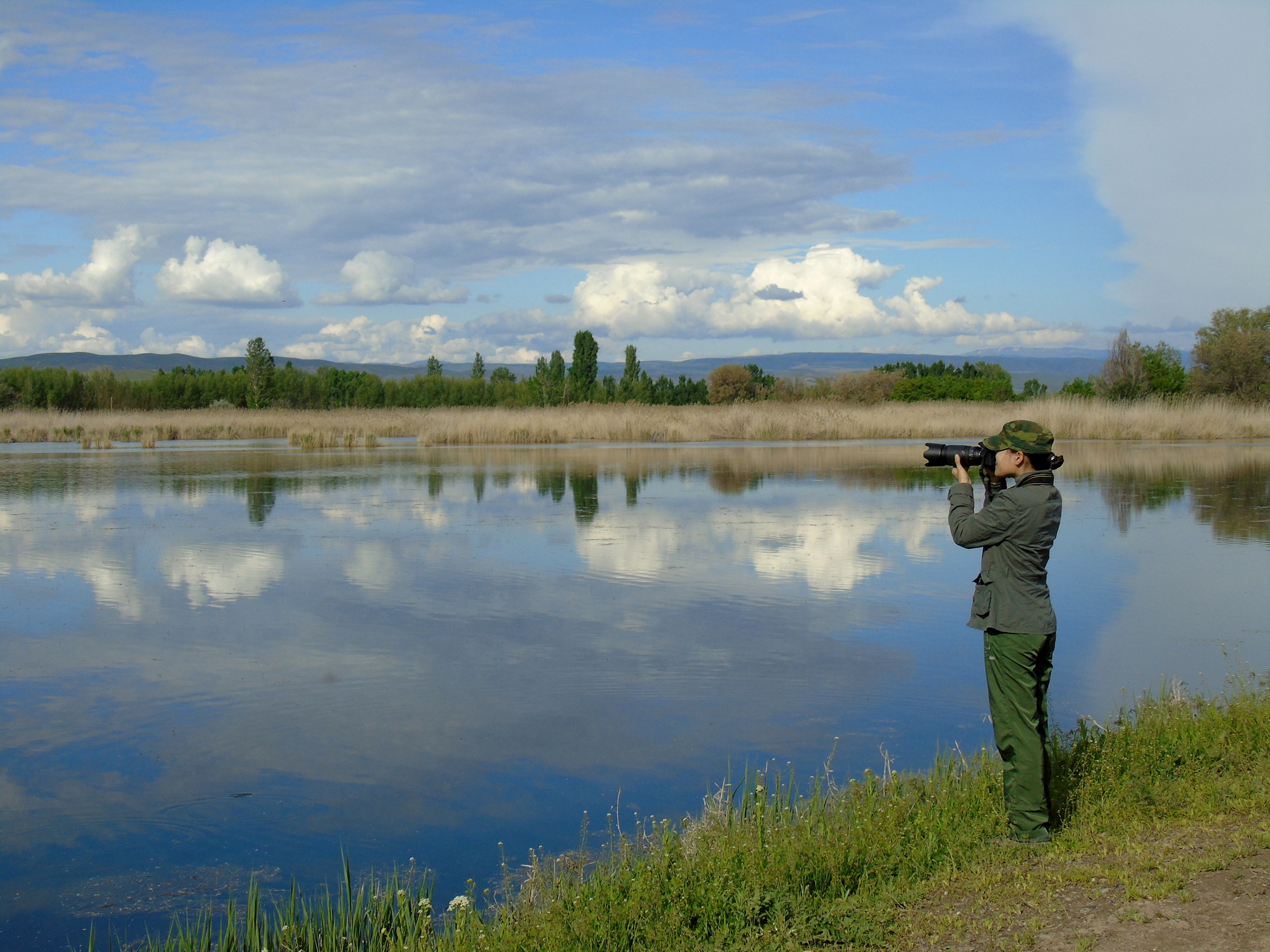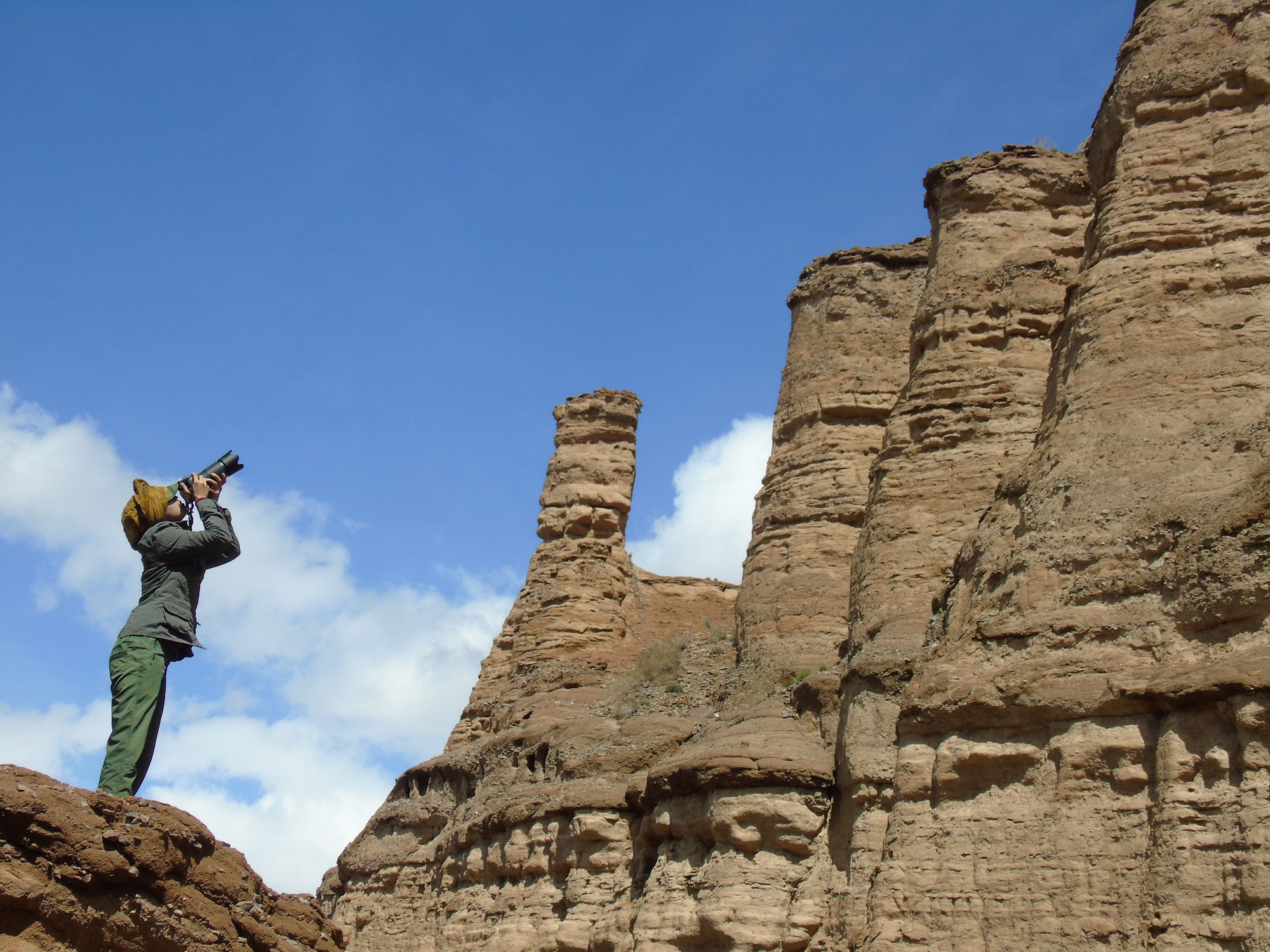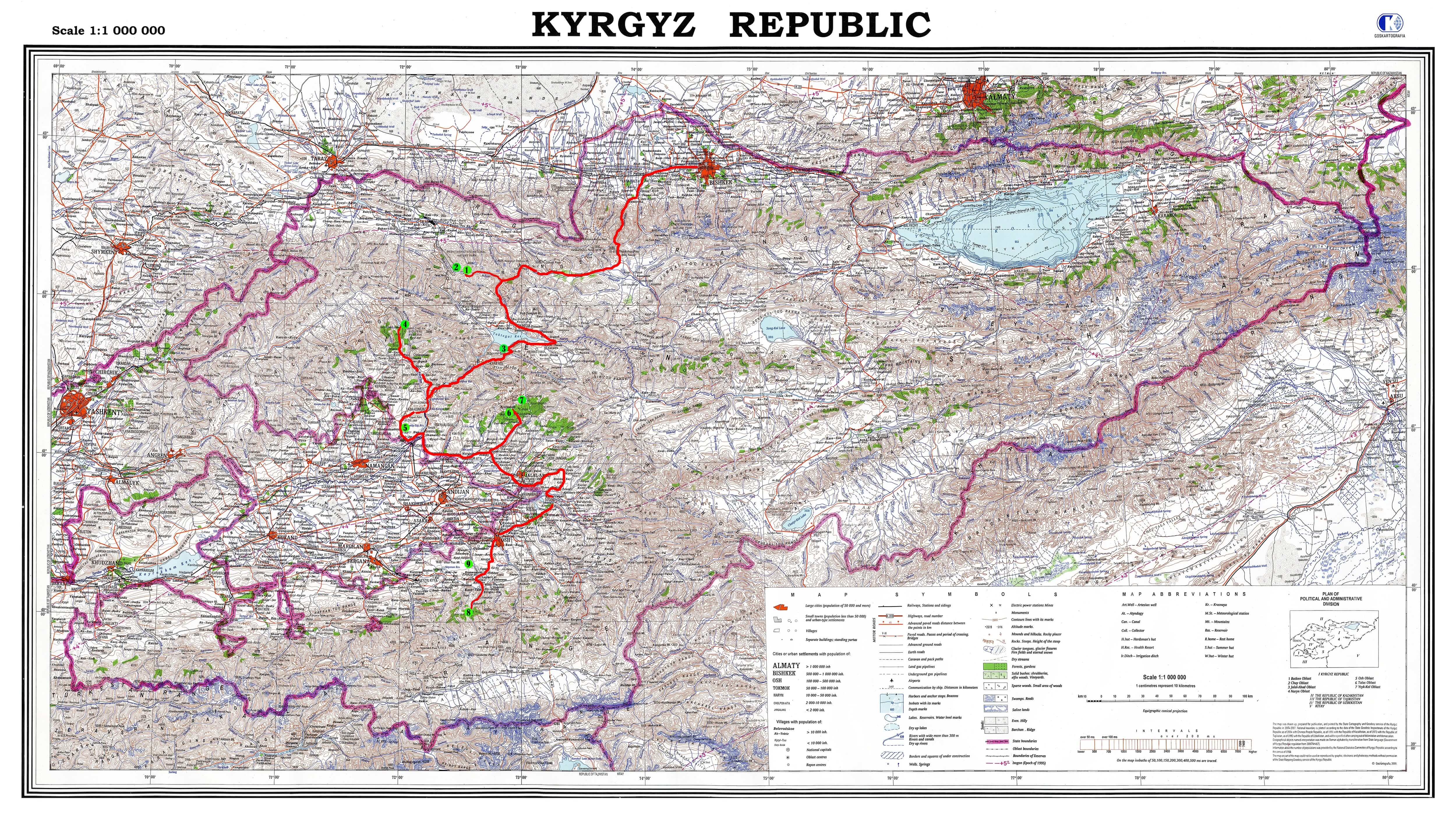Birdwatching in biosphere reserves is of great pleasure, as there is a great opportunity to see many different species of birds. The reserves Sary-Chelek and Arslanbob are the world famous unique biosphere territories in Central Asia.
The Sary-Chelek Biosphere Reserve is a specially protected natural territory of Kyrgyzstan, located between the Chatkal and At-Oinok ridges. These are the most humid places in both Kyrgyzstan and Central Asia. Here is a mild temperate climate and an abundance of diverse vegetation. The reserve was created in 1959. In 1979, the reserve was incorporated into the international network of biosphere reserves of the UNESCO. The main landscape element of the reserve is the Sary-Chelek Lake. The lake with its clean and fresh water covers an area of about 5 square km and has a maximum depth of 246 m. In the vicinity of the main lake, there are 6 smaller lakes. The water temperature is different in each of the lakes. Perhaps this circumstance creates different natural conditions for the fauna that lives near the Sary-Chelek lakes. The climate is warm in summer and with little snow in winter. A significant part of the reserve is occupied by walnut, apple and pear forests. The rare fauna includes such animals as the: muskrat, red deer, fallow deer, porcupine, marten, argali, wild boars, and capricorn, as well as 157 different species of birds. The Sary-Chelek Reserve is a unique natural heritage of Central Asia.
The Dashman Reserve is the only walnut paradise in the world. Located on the southwestern slopes of the Fergana Range. It is also one of the most humid areas of Kyrgyzstan and Central Asia. The greatest amount of precipitation falls here. This is thanks to the Fergana Range, which serves as a barrier on the way of the north-western humid air currents. The range serves as a moisture accumulator. The geographical location and natural factors determined the conditions for the world’s largest walnut forest here. Scientists are still arguing about the age of these walnut forests. Walnut forests constitute a separate oasis representing the relic of deciduous forests of the Tertiary period. But the tertiary period has a large interval of geological history. It starts from the extinction of dinosaurs in the Cretaceous-Paleogene period and ends before the beginning of the last ice age, about 1.8 million years ago. During this time, the climate has experienced significant changes, the walnut forests of Arslanbob are witnesses of these global changes. So how old are the Arslanbob walnut forests? We will answer this and other questions on our field trip. Many species of birds that we will try to see live in Arslanbob.
The Kyrgyz-Ata National Park. A big territory of the park is a botanical reserve, created to preserve the juniper forests, mountain tulips and saffron. Basically, the Zeravshan and Turkestan juniper species grow here; more than 200 animal species live here. Here you can see the snow leopard, lynx, wolf, hare and fox.
Natural Park Ala Archa. It is located at a distance of 41 km from Bishkek on the northern slope of the Kyrgyz Range at an altitude of 1600-4860 m. The Ala-Archa River flows through the park. Landscapes are represented by foothill steppes and mountain forests, where more than 600 species of higher plants grow, including 70 species of trees and shrubs, about 50 species of medicinal plants, a lot of honey plants and tannins. Of the animals, argali, Siberian roe deer, Capricorn, wild boar, roe deer, fox, wolf, hare, badger, ermine, porcupine, marten live here; partridge, chill, cupcake, ular are common. Of the rare animals found Turkestan lynx, serpent eater, golden eagle, Kumai, Saker falcon; snow leopard and vulture
Program. The duration of the program is 12 days. The duration can be changed at the request of the participants. The total length of the route is about 700 km. The program is flexible. The route of the trip crosses the Northern Tian-Shan, Western Tian-Shan and Southern Tian-Shan. We will see how the altitudinal zonality, natural landscapes, climate, flora, fauna, and culture of people change. The most favorable time for the trip is April – May. At this time we can see the spring and autumn migrations of birds. Useful tips for birdwatchers
Photos of some birds of Kyrgyzstan
Arrival in Bishkek. Meeting at the airport. Briefing – acquaintance with the program and the local guide expert. Lecture on reserves and birds Kyrgyzstan. Overnight in hotel.
Ala-Archa Natural Park is located at a distance of 41 km from Bishkek on the northern slope of the Kyrgyz Range at an altitude of 1600-4860 m. The Ala-Archa River flows through the park. Landscapes are represented by piedmont steppes and mountain forests. From birds you can see cupcakes, Ular, thrushes, brown and common dipper, bearded vulture, snake-eater, white-headed vulture, golden eagle, long-legged buzzard, red-footed hawk, pheasant, red-necked hawk, ringworm, ringworm alpine jackdaw, Muscovite, red-headed tit, redstart, bluebird and many other interesting birds. Overnight in Bishkek.
Within 4-5 hours we will ascend to the subalpine high-altitude belt. The Suusamyr Valley is located at an altitude of about 2300 m. Here are alpine meadows and many nomadic summer camps. Then we will begin the descent into the zone of mountain forests. Here is located the beautiful Saz-Kel Lake surrounded by a woody forest and different shrubs. In summer, the Saz-Kel Lake becomes a place for the life of local nomads. Local people establish yurts, graze cattle and make dairy products here. Many people pick wild berries, which are abundant here. It is a beautiful and almost wild place for field camps and birdwatching. Besides ornithologists, this gorge attracts biologists as well as lovers of flora and fauna. The mountain collapse that occurred here several thousand years ago blocked the gorge, creating the conditions for the formation of the Itagar Lake. Birdwatching, Location 1. Overnight in tents.
Excursion to the Itagar gorge and birdwatching, Location 2. Today we will get into a wide valley located up the gorge. Here, at the confluence of the rivers, you can see various birds in dense thickets of bushes and spruce trees. Return to the camp. Overnight in tents.
Along the way, we plan to stop for lunch on the shore of the Toktogul reservoir. This is the largest artificial reservoir in Central Asia, which was built as a reservoir for the Toktogul hydroelectric station, Location 3. Here you can see such rare birds as: Lammergeier (Gypaetus barbatus); Demoiselle-Crane (Anthropoides virgo); Tawny Owl (Strix aluco). Here you can find the very rare species – Eastern Imperial Eagle (Aquila heliaca). Further, moving to the south, we get to the desert-steppe belt of the eastern part of the Fergana Valley. Some species of semi-desert birds inhabit here. Then we will ascend the mountain forest belt in the vicinity of the Sary-Chelek Lake. Excursion in the vicinity of the lakes. Choosing a convenient location for birdwatching. Overnight at guest house.
The Sary-Chelek Reserve is a place where you can have an exciting and romantic birdwatching. You can see how the birds make their nests, nest, find food, breed, Location 4. The best photos can be made during their mating season. Here you can see such rare species of birds as: Red-necked Grebe (Podiceps auritus), Cormorant (Phalacrocorax carbo), Gray heron (Ardea cinerea), Pintail (Anas acuta), Merganser big (Mergus merganser). Patient birdwatchers can see the hunt of the Osprey (Pandion haliaetus), that hunts fish. You can also see the Goshawk (Accipiter gentilis) hunt. Here you can also watch the White-tailed Eagle (Haliaeetus albicilla), Falcon Peregrine Falcon (Falco peregrinus), Checkpoint (Falco subbuteo), Saker (Falco cherrug). Near the lakes you can see the Coot (Fulica atra), Anthropoides virgo, Lapwing (Vanellus vanellus), Yellow-headed Wagtail (Motacilla citreola) and other birds. Sary-Chelek has very rich feeding conditions for different birds. Therefore, this place is of great importance during the migration of birds. Overnight at guest house.
We move to the next unique reserve – Arslanbob. On the way we visit: Kyzyl-Dzhar savannah. Gradually we get into the desert-steppe belt. In the lower part of the Naryn River, the landscape resembles a savannah alternating with a mountain-semi-desert. This landscape is a great place for semi-desert birds. The best time to visit these places is in spring. The spring period is very important for the seasonal life of plants – they get too little water in these little snowless places. At this time there are many "ephemera" – annual plants with a very short development cycle, which are the main flora of deserts. There are also many “ephemeroids” with a short growing season. Fergana tulips and crocuses start to bloom here. Together with the plants, the life of birds also becomes active here. Due to the relative proximity of the Naryn River and several reservoirs, many species of birds have adapted to live here. We will stop to watch birds here, Location 5. Here you can meet such rare birds as: Oatmeal gall (Emberiza bruniceps), Seahorse (Anthus campestris), Crested lark (Galerida cristata), Roller (Coracias garrulus), Nightjar ordinary (Caprimulgus europaeus), Steppe Kestrel (Falco naumanni). If we are lucky, we will see the Steppe eagle (Aquila nipalensis) here. On the way we can also observe the White stork (Ciconia ciconia). In the afternoon we will arrive in Arslanbob. Arslanbob is an excellent example of a concept for the development of eco-tourism. Ecotourism develops here thanks to the locals who are directly involved in the organization of ecotourism and are part of it. Hundreds of plant species in the form of grasses, shrubs and trees have created here excellent conditions for hundreds of bird species. In the evening, we will have dinner with popular national dishes. Overnight at Uzbek guest house.
Today we will visit the walnut institute, and we will make a tour of the walnut forests. Local conditions are slightly different from previous ones in Sary-Chelek. This zone of forests, borders with rocks and gorges. We will watch birds on the border of the forest zone and high limestone rocks to see the diversity of the avian fauna of Arslanbob. Today we will make an excursion to the famous waterfalls. These waterfalls made Arslanbob popular and the site of a large number of pilgrims from all over the Fergana Valley. For Muslims, waterfalls are sacred. Excursion on old military off-road cars or on horseback will be the best way to get acquainted with the surroundings and the locals, Location 6. During the spring and autumn migrations, you can see such birds as: Goshawk (Accipiter gentilis), Sparrowhawk (Accipiter nisus), Falcon Peregrine Falcon (Falco peregrinus); Common Kestrel (Falco tinnunculus); Keklik (Alectoris chukar); Turtle Dove (Streptopelis decaocto); Ringdove (Columba palumbus); Owl eared (Asio otus); Scoop (Otus scops); White Wing Woodpecker (Dendrocopus leucoptera), Rocky Bunting (Emberiza buchanani), Flycatcher Paradise (Terpsiphone paradise). If we are lucky, we will see here a rare bird – the Snake eater (Circaetus gallicus), as well as other rare birds, Location 7. Overnight at guest house.
Further, our route will lead us to the south of Kyrgyzstan. Today we will arrive in the Osh City, this was an ancient trade hub on the Great Silk Road. We will have a city tour. A visit to the historical and archaeological complex "Osh-3000". Dinner at a national restaurant. Seminar about birds in the south of Kyrgyzstan. Overnight at hotel
The Kyrgyz-Ata National Park is located 40 km south of the Osh City. Most of the park is occupied by a botanical reserve, created to preserve the juniper forests, mountain tulips and saffron. Mostly, Zeravshan and Turkestan juniper species grow here, more than 200 animal species live here. Here you can see the snow leopard, lynx, wolf, hare and fox. And also there are different types of birds. Another part of the park is occupied by the Dangi Canyon with rock paintings and several caves. In the caves, large calcite crystals are formed. On the high walls of the canyon in the grottoes, we can observe the nests of mountain eagles. The southern part of the national park is a combination of juniper forests and a limestone mountain massif. Today we will find convenient and suitable places for birdwatching. Overnight at the National Park Hotel.
We will make an excursion in the national park. Here you can see such predators as the: Golden eagle (Aquila chrysaetus), Falcon Peregrine Falcon (Falco peregrinus), Quail ordinary (Coturnix coturnix), Owl (Bubo bubo), Hawk Owl (Surnia ulula), Hoopoe (Upup epops), White Wing Woodpecker (Dendrocopus leucoptera), European bee-eater (Merops apiaster). Here you can see such species of birds as the Mountain Wagtail (Motacilla cinerea), which winter in South Africa and in southern Asia. Also here you can see the: Masked Wagtail (Motacilla personata), Red-tailed Shrike (Lanius isabellinus). And also the most beautiful species of the shrike family, the Black-faced Shrike (Lanius minor), Archaur goose (Mycerobas carnipes). If we are lucky, we will see here a very rare species, the Shikra (Accipiter badius). Kyrgyz-Ata is a paradise for many birds, Location 8. Overnight at hotel
Today, we are heading to Tuya-Muyun, towards the Dangi canyon. This is a very convenient place to observe the flying predatory owners of the mountains, living in the grottoes on the vertical rocks of the canyon, Location 9. Tuya-Muyun is the favorite place of local speleologists. There are several beautiful caves with rare formations of calcite crystals. The small mountain range Tuya-Muyun and the Dangi Canyon is a surprisingly epic place, especially in spring. At the bottom of the canyon flows the river Aravansai. On the steep vertical cliffs, there are numerous grottoes where live the Egyptian Vulture and the Eurasian Griffon – the owners of these places. We climb to an easily accessible plateau and go to the edge. On the edge of the cliff, there is an excellent platform for watching birds floating in the air. This place is located above some grottoes with bird nests; therefore we can observe and photograph these graceful flying predators from a bird's-eye view, being above them or at the level of their flight. Eagles circle over the canyon in the ascending air from the canyon. Here you can watch the Egyptian Vulture (Neophron percnopterus) and the Eurasian Griffon (Gyps fulvus). Here you can also find the Eurasian Eagle-Owl (Bubo bubo). Sometimes you can see very rare species here, such as: Bonelli’s Eagle (Hieraaetus fasciatus), Lammergeier (Gypaetus barbatus). In the evening transfer to the Osh City. Short seminar, exchange of information and impressions. We will have a banquet. Overnight at hotel
Transfer to the airport of Osh.
- - Meeting and seeing off at the airport
- Accommodation in hotels 3 * according to the program (double occupancy) - - Flights from Osh to Bishkek
- Three meals a day for the whole program,
- Transport according to the program,
- Guide-expert,
- Entrance fees to reserves,
- Bottled water
- - International air fare to Bishkek / Osh and back
- Rental of individual equipment
- Surcharge for single occupancy
- Cost of visa and consular services
- Personal expenses in a hotel: bar, international calls, etc.
- Insurance
- Any changes to the program - - Visa
Price on request
According to the request and interest, we can negotiate the optimal price for your budget.
Price depends on the number of participants
Accommodation in hotels:
– Bishkek – 1 nights
– Sary-Chelek – 2 nights
– Arslanbob – 2 nights
– Osh – 2 night
– Kyrgyz-Ata – 2 nights
Total – 9 nights
Tent accommodation:
– Saz-Kel Lake – 2 nights
Total – 2 nights
The optimal number of participants is 2-7 persons
Alternative tour option for 7 days
Day 1. Bishkek – Sary-Chelek Nature Reserve
Day 2. Observations in Sary-Chelek
Day 3. Sary-Chelek – Kyzyl-Jar savannah – Tash-Kumyr
Day 4. Tash-Kumyr – Osh
Day 5. Osh – Tuya-Muyun Mountains – Dangi Canyon
Day 6. Osh – Chilisay Valley
Day 7. Osh – Airport
Tour cost on request
Our email: info@geoexplorersclub.com




